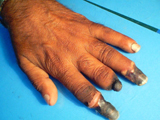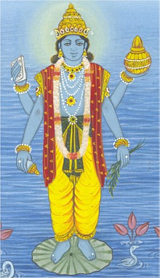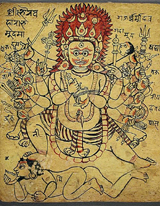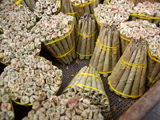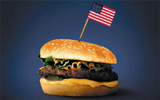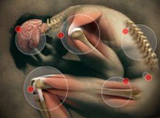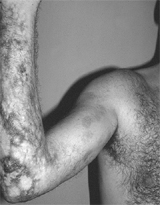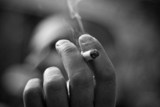Āyurveda
An overview of Buerger’s disease (Thrombo angitis obliterans) in Āyurveda
Editor's note
Each age of mankind has its own unique way of understanding and relating with the world around it. Āyurveda belongs to an intuitive age of mankind that precedes the age of rational enlightenment as it also precedes the age of darkness and superstition. However, the two ages that followed it, like night and dawn, disintegrated much of this knowledge and whatever remained was further lost in semantics. It is now difficult to know exactly what each word used in that age stood for unless we enter into an inner sympathy with it. The article is an interesting attempt to bridge the gap between the two ages, the ancient wisdom and modern knowledge using a rare disease as its model.
Introduction
TAO (Buerger’s disease) is an inflammatory condition of the small and medium-sized blood vessels of the arms and legs, leading to an insufficient supply of blood to the tissues, causing pain, discoloration and finally resulting in gangrene. There are a few diseases described in Āyurveda, such as vātarakta, dhaminī praticaya and ghanastravahikajanya śotha, which to some extent have symptoms comparable to TAO.
The multiplicity of classifications and variations in the understanding of this disease in the various systems of medicine makes the issue complex. Ghanastravahikajanya śotha is a coined term equivalent to TAO but dhamanī praticaya, mentioned by Aṣṭañga Saaṅgraha in his sūtrasthāna would be more appropriate and also more reasonable to our knowledge. The following verse substantiates this view:
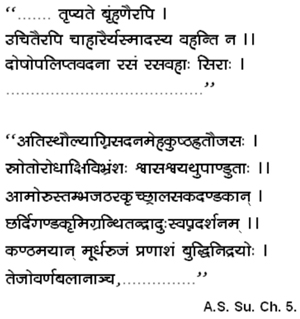
1. Brimhaniyata: in spite of the intake of nourishing food.
2. Ucita: balanced and wholesome diet.
3. Trrpyate api: leading a normal and pleasant life.
4. Doṣopaliptavadanaha: being narrowly pasted by morbid dossas.
5. Asyarasavaha śirā: the vessels of such a person.
6. Rasaṁ na vahanti: becomes unable to transport plasma or blood.
Even a person with no abnormal mental emotions, who is leading a pleasant life without considerable stress and strain and is nourished by a wholesome and balanced diet, can allow his or her arteries to get pasted by morbid matters. Swelling and thickening of the muscular walls occurs as a result and the walls become rigid and quite incapable of performing their normal function of transporting blood to meet the requirements of the organs. This will cause excessive accumulation of vitiated doṣas, leading to various diseases caused by dhamanī praticaya due to the deposit of morbid doṣas in the blood vessels. Hence, dhamanī praticaya can be considered similar to Thrombo angitis obliterans or Buerger’s disease.
Caraka mentioned the term dhamanī as one of the synonyms of srotas. Channels of circulation or tracts within the body are called srotas because of the trickling or oozing of various secretions through them. They are the pathways for nutrients or waste-products of body metabolism to reach their destination. Caraka saṁhitā points out that these are only the channels of circulation, and as such are different from the substances that are carried through them. They are śirā, dhamanī, rasayana, rasavahinī, nāḍi, pandhaaṅa, mārga, śarīrachidraṇi, saṁvṛtta, asamvuthani, sthāna, asayam and nikathanam. While explaining ssiraa and dhamanīs as synonymous to srotas, their number and functions have been separately mentioned. There are characteristic ways in which normal functions of the channels are disturbed and the specific treatments prescribed to correct such disorders. Channels carrying blood are disturbed by over-indulgence, by unctuous and hot food and drinks, and by over-exposure to the sun and fire. Symptoms related to this srotas include pallor, flushing, fever, burning sensations, haemorrhage and others. Treatment options in this regard also mention bloodletting as a final measure. Thinking on these grounds, excessive indulgence in smoking (dhūmrapāna) may vitiate raktavaha srotus resulting in the above symptoms, which are comparable to symptoms of Thrombo angitis obliterans or Buerger’s disease.
Caraka saṁhitā states when the aggravated doṣas, with certain aetiological factors such as smoking, cause it to enter into the āmāṣaya, interacting with the digestive fire, it results in the formation of āma. This āma probably obstructs the srotus of the lower limbs, resulting in doṣaduṣya sammurchanā and finally establishes the disease.
Types of sroto duṣṭi
There are four types:
1. Atipraviti
excessive production of any particular dhātus.
2. Sanga
obstruction of dhātu, causing localisation of the disease process.
3. Granthi
This is a condition where the blood vessels become tortuous, dilated and engorged.
4. Vimarga gamanam
This is nothing but deviation of the morbid material to other new areas.
Aetiological factors
According to Āyurveda, various factors like asthmendriyardasamyoga, pragyaparadha and pariṇāma, due to their atiyoga, ayoga and mithyā yoga, promote the manifestation of various diseases. Here, in the manifestation of TAO or Buerger’s disease or dhamanī praticaya, excessive smoking of beedis or cigarettes along with other tridoṣa-provocating factors are held responsible. Here, atiyoga of smoking, resulting in prajñaparadha, is likely to become injurious to the individual’s body and mind. To conclude on the various factors and their role in manifesting this disease, a thorough evaluation of various factors has been presented in tabular form.
Table Nn.1
Vata prokapaka aahara vihara
Aahara |
Vihara |
Manasika |
| 1. Excessive intake of ruksha ahara | 1. Excessive intercourse | 1. Excessive shock |
| 2. Excessive intake of kaṭu, tikta kasaya dravya | 2. Excessive exercise | 2. Excessive fear |
| 3. Gram,pea, moonga,masoora | 3. Night awaking | 3. Excessive feeling of guilt |
| 4. Dry food | 4. Vega vidharana | |
| 5. Alpa bhojana, upavasa, visamasana | 5. Dhatu kshaya | |
| 6. Trauma | ||
| 7. Excessive blood-loss | ||
| 8. Fast running, swimming, jumping |
||
| 9. Atiyoga of vamana virecana |
Table No. 2
Pitta prokopaka aahara vihara
Aahara |
Vihara |
Manasika |
| 1. Excessive intake of kaṭu, amla | 1. Dhumrapana | 1. Excessive anger, Lavana, ushna, tikṣna, vidahi āhara |
| 2. Virrudhasana tila, curd, surā (wine) kanji, mustard, kulattha | 2. Agni sevana | 2. Excessive fear |
| 3. Fish, meat, goat, | 3. Excessive exercise | 3. Excessive śoka |
| 4. Fast eating habits | 4. Walking under sunlight | 4. Excessive jealousy |
| 5. Śarat and griṣma ṛitu | ||
| 6. Madhyāna kāla and ardharātri |
Table No.3
Kapha prakopaka nidana
Aahara |
Vihara |
Manasika |
| 1. Excessive intake of guru, madhura and snigdha dravyas | 1. Sleeping in the daytime | 1. Excessive feeling of happiness |
| 2. Milk products | 2. Ati nidrā | 2. Satisfaction |
| 3. Curd | 3. Less Physical work and less exercise | 3. Tension-free life |
| 4. Śita dravya, Picchila dravya | 4. Vasanta, Śiśira Hemanta ṛtu | 4.Tamoguṇa |
| 5. Ati santarpana | 5. After food intake | |
| 6. Adhyāsana | ||
| 7. Fatty diet |
Table No. 4
Rakta prokopaka aahara hetu
Aahara |
Vihara |
Manasika |
| 1. Excessive intake of amla, lavana, kaṭu, kshara, tikshna and ushna dravyas | 1. Agni sevana | 1. Krodha |
| 2. Excessive intake of vishamsana | 2. Ātapa sevana | 2. Śoka |
| 3. Tila, kultha, mustard alsi, curd, kurcika souviraka, citrus food, meat | 3. Excessive coitus | 3. Excessive fear |
| 4. Jalaja, ānupaja, māṁsa sevana | 4. Upavāsa | 4.Tamogunna |
| 5. Excessive labour | ||
| 6. Vaman vega vidharana | ||
| 7. Sarat ṛtu |
Pūrva rūpa (pre-monitory symptoms)
The prodromal manifestation of the disease helps in assessing the disease in advance through its advance clinical manifestation of signs and symptoms.
Pūrva rūpa of Buerger’s disease:
1. Suptita (numbness)
2. Pindikodveṣṭana (muscle pain)
3. Vedanā (pain)
4. Vivarnyata ( discoloration)
5. Dāha (burning sensations)
Rūpa (signs and symptoms)
The manifestation of symptoms in a full-blown manner reveals the total establishment of the disease. Here, there is no excuse for the physician or surgeon to miss the diagnosis after observing the full-blown status of the disease in the patient.
1. Ati Ruja / vedanā (pain): when the srotas get obstructed due to various provocation factors, there is severe pain in the limb.
2. Anidrā (insomnia): provocation of vāta doṣa causes obstruction in the dhamanīs, resulting in pain and anidrā.
3. Dāha (Burning sensations): an associated important symptom, due to excessive presence of pitta doṣa is burning sensations in the limbs.
4. Pāka (inflammation): due to pitta vitiation, local tissues are destroyed and converted into rāga, resulting in active inflammation.
5. Duṣṭa vraṇa (chronic ulceration): the end-stage of inflammation causes pāka in the local tissues, resulting in macroscopic destruction and causing duṣṭa vraṇa.
6. Vaivarṇya (discoloration): an important clinical change is local discoloration in the tissues of the involved limbs.
7. Sparśasahanatva: this status of hyper-sensitivity results in local damage of the nerve-ends.
8. Shopha (oedema): this oedema causes dhātuutkleṣaṇa resulting in srotarodhā.
9. Māṁsa kotha (gangrene): the cessation of the nutritional status finally results in māṁsa kotha.
Upshaya
In the trial and error technique to find the exact aetiological factor, upshaya helps in assessing the quantum and nature of the disease. If avoiding beedi or cigarette smoking gives symptomatic relief, it confirms the existence of the disease.
Samprāpti
This is useful not only in diagnosis but treatment too. It is impossible to finalise a treatment schedule without the information on doṣa and duṣya along with their fractional involvement. An intelligent physician can predict the symptoms of a concealed disease, if he can recognise samprāpti by the analysis of doṣa vitiations.
This understanding helps Āyurvedic practitioners to face the challenges imposed by the various implications of diagnosis and helps them to adhere to a particular Āyurvedic regimen.
Table No. 5
Samprāpti cakra (comparative aetiopathogenesis manifestation cycle)
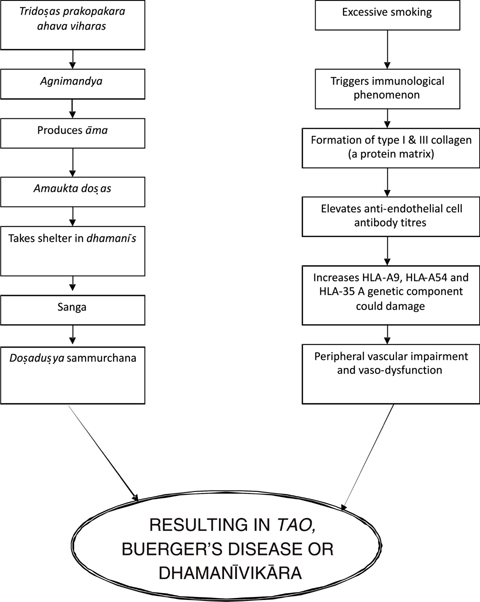
Summary
Various aetiological factors (see Table nos. 1-4) are capable of producing āma formation. This āma, when joined with the normal doṣas, converts them into āmayukta doṣas causing sthānasmmasraya to take shelter in the dhamanīs, resulting in doṣaduṣyasammurchanā manifesting pūrvarūpa, followed by the establishment of full-blown disease (see Table no. 5). Even contemporary science in this aspect reveals that heavy smoking can trigger the immunological phenomenon, releasing the formation of an āma-like substance of Type I & Type III collagen, a protein matrix (Table No:6). This process elevates anti-endothelial cell antibody titers similar to sthānasaṁśrayam (dislodgement of the doṣas) and by increasing HLA-A39, HLA-A54 and HLA 35, a genetic component similar to the result of the doṣaduṣyasammurchanā manifests, establishing pūrvarūpa peripheral vascular impairment and vaso-dysfunction similar to and finally causing TAO (Buerger’s disease) or dhamanī praticaya of dhamanīvikāra.
Bibliography
1. Adam, S.L., The Medicinal Leech: a page from the annelids Medicine. Ann Intern Med. 1998; 109: 399-405.
2. Cott, H.H.G. Arterial Surgery. London; Pitman Medical Publishing Company Limited, 1969.
3. Daane, S., Zamora, S., Rockwell, W.B. Clinical use of leeches in reconstructive surgery. Am J. Orthop 1997; 26: S28-S32.
4. Devaraj, T.L. The Pancakarma treatment of Āyurveda. Sri Satguru Publications, 1998.
5. Dhyani, V.S.C. Sharer Kriya Vijnaniyam (Part 1).
6. Gray, H. Anatomy Descriptive and Applied. 23rd edition 1926.
7. Kohli, K.R. Ayurvedic approach to arthritis and its drug management. Āyurved Mahasammelana Partika, 1995.
8. Mistry, P. N. A dissertation of 40 cases of Thrombo Angitis Obliterans with a comparison of the result of operative and non-operative methods of treatment practiced on them. Jaipur; SMS, 1960.
9. Modi, J.C. An epidemiological and clinic therapeutic study of Buerger’s disease. Jaipur; SMS, 1996.
10. Pandey, D.S. Mādhavanidāna. Varanasi; Chaukhambha Sanskrit Santhana, 1994.
11. Pandey, D.S. Sharangadhara saṁhitā. Varanasi; Chaukhambha Sanskrit Series, 1966.
12. (ed.) Russell, R.C.G., Williams, N.S. Bailey and Love’s short practice of Surgery. Arnold, 2000.
13. Sharma, P, V. Suśruta saṁhitā (English). Varanasi; Chaukhambha Visvabharati, 1999.
14. Sharma, S.K. Shalya Vigyana. Savita Prakashana Patiyala, 1991.
15. Sharma, V.R. Roga vigyana. Jaipur; Vaidya Publication Scheme, 1993.
16. Shastri, K.A. Suśruta saṁhitā (Hindi). Varanasi; Chaukhambha Sanskrita,1993.
17. Shukla, V. Kaya cikitsā (Part 1). Varanasi; Chaukhambha Surbharti Prakashana, 1995.
18. Singh, R. Kaya cikitsa. Varanasi; Chankhambha Sanskrit Series, 2002.
19. Snell, R.S. Clinical Anatomy for Medical Students. Toronto; Little Brown and Company, Toronto, 1986.
20. Trikumji, J. Suśruta saṁhitā (Sanskrit), Dalhana’s Commentary. Varanasi; Chaukhambha Surbharati, 1994.
Dr. Martha Bhaskar Rao is Professor at the Department of Shalya Āyurvedic College & Hospital, Tirupati.
Dr. Hemanth Kumar Kushwaha is Professor and Head of the Postgraduate Department of Shakyatantra, National Institute of Āyurveda, Jaipur.
Share with us (Comments, contributions, opinions)
When reproducing this feature, please credit NAMAH, and give the byline. Please send us cuttings.
